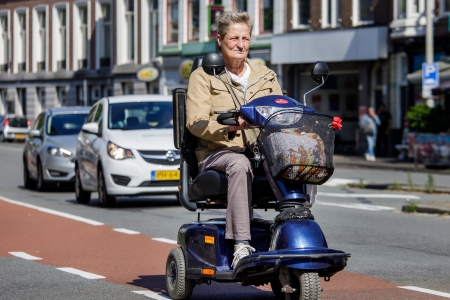Mobility scooters and enclosed disability vehicles
In 2018 and 2019, the number of road deaths among users of mobility scooters and enclosed disability vehicles in the Netherlands amounted to more than 40. In 2010-2019 the number fluctuated but showed a marked increase (Figure 3).
 Figure 3. Development of the number of road deaths among mobility scooter users and occupants of other disability vehicles in 2010-2019. Source: Statistics Netherlands (Datalink).
Figure 3. Development of the number of road deaths among mobility scooter users and occupants of other disability vehicles in 2010-2019. Source: Statistics Netherlands (Datalink).
There are no recent, reliable data about the number of (serious) road injuries among users of mobility scooters and occupants of other disability vehicles. The most recent information dates back to 2011 and is based on the Injury Information System of VeiligheidNL [10]. This shows that, in 2011, about 2000 road users were treated at emergency rooms after a mobility scooter crash. About one in three (36%) were admitted to hospital for treatment. Of the 115 casualties who completed a questionnaire for this study, almost half (48%) had sustained fractures during the crash and 46% superficial injuries [10]. Leijdesdorf et al. [11] also studied injuries after mobility scooter crashes. Their study concerned 242 casualties admitted to hospital in 2003-2013. Half of them (51%) were aged over 75. Half of them had sustained a single serious injury, 15% multiple serious injuries and 4% died during their hospital stay.
When setting off the number of road deaths among users of mobility scooter and occupants of other disability vehicles against the number of kilometres travelled according to the OdiN mobility study (for 2018-2019), we arrive at a risk of about 275 road deaths per billion kilometres. This is a far greater risk than that run by motorcyclists (50 road deaths per billion kilometres), (light) moped riders (42 road deaths per billion kilometres), cyclists (13 road deaths per billion kilometres) and pedestrians (11 road deaths per billion kilometres) (in 2010-2019, [12]). It should, however, be noted that the number of mobility scooter kilometres travelled according to the ODiN data is probably underestimated (also see the question How many mobility scooters, enclosed disability vehicles and microcars are there in the Netherlands and how often are they used?) which implies the actual risk will be lower.
It is plausible that mobility scooter users who are involved in crashes sustain serious injuries more often than other unprotected road users such as cyclists and light moped riders. This is due to their relative advanced age and to the fact that they are often less healthy than their peers who do not need to use mobility scooters. So, mobility scooter users are often physically vulnerable and a fall or collision will more often have serious physical consequences. The enclosed body of other disability vehicles will offer its occupants more protection during a collision, but still rather a great deal less than heavier ‘ordinary’ cars (see the question What about crashworthiness? ).
Microcars
The actual number of road deaths among microcar occupants is unknown; when computing the actual number of road deaths, the data for microcars and (light) mopeds are aggregated. We do know that the Dutch police register an annual number of approximately three road deaths among microcar occupants (2010-2019), but is unknown how comprehensive the registration is. The actual number of serious road injuries among microcar occupants is also unknown.
As was the case for enclosed disability vehicles, the enclosed body of microcars offers significantly less protection in case of a collision than heavier ‘ordinary’ cars (see the question What about crashworthiness?).
